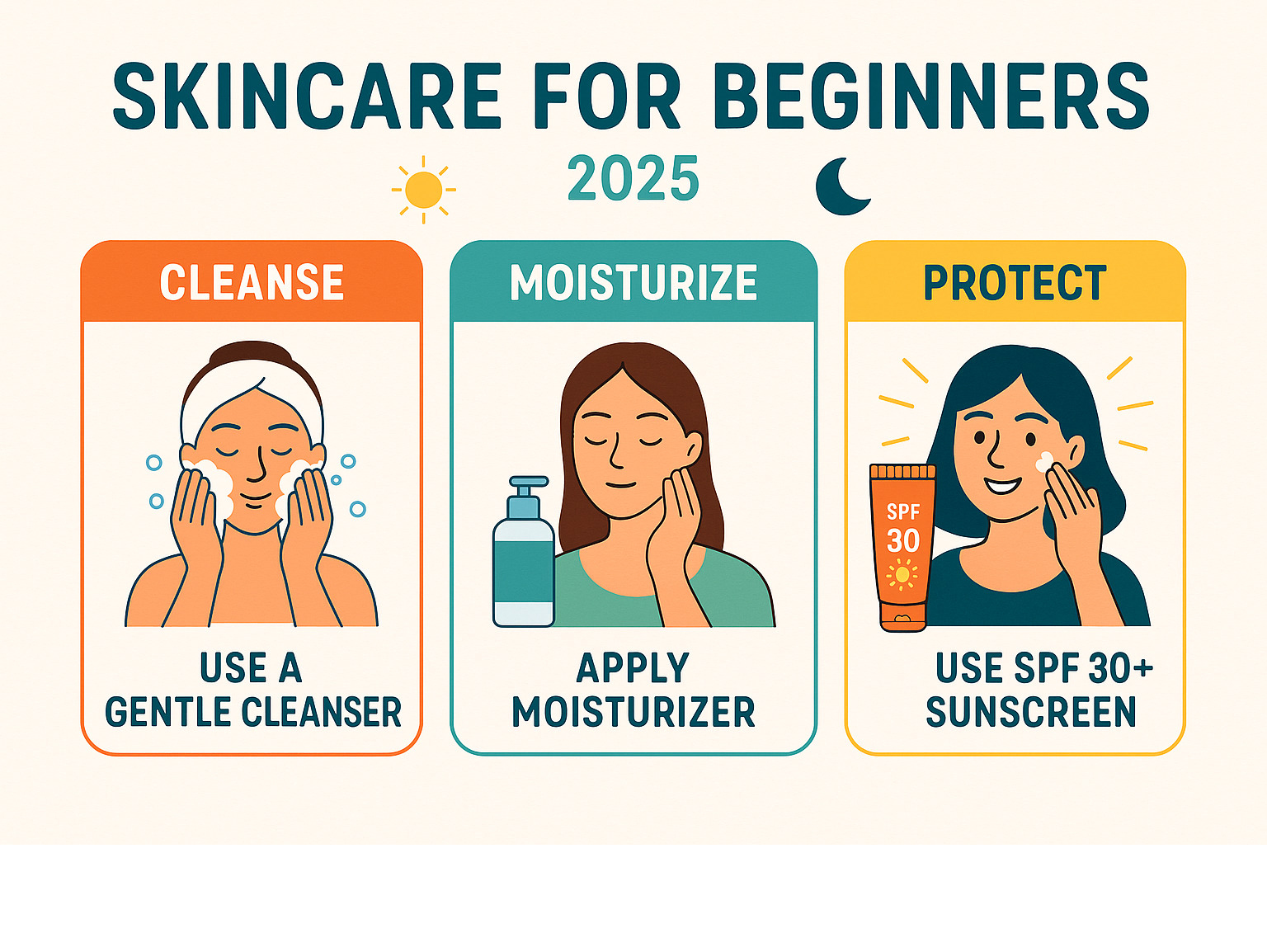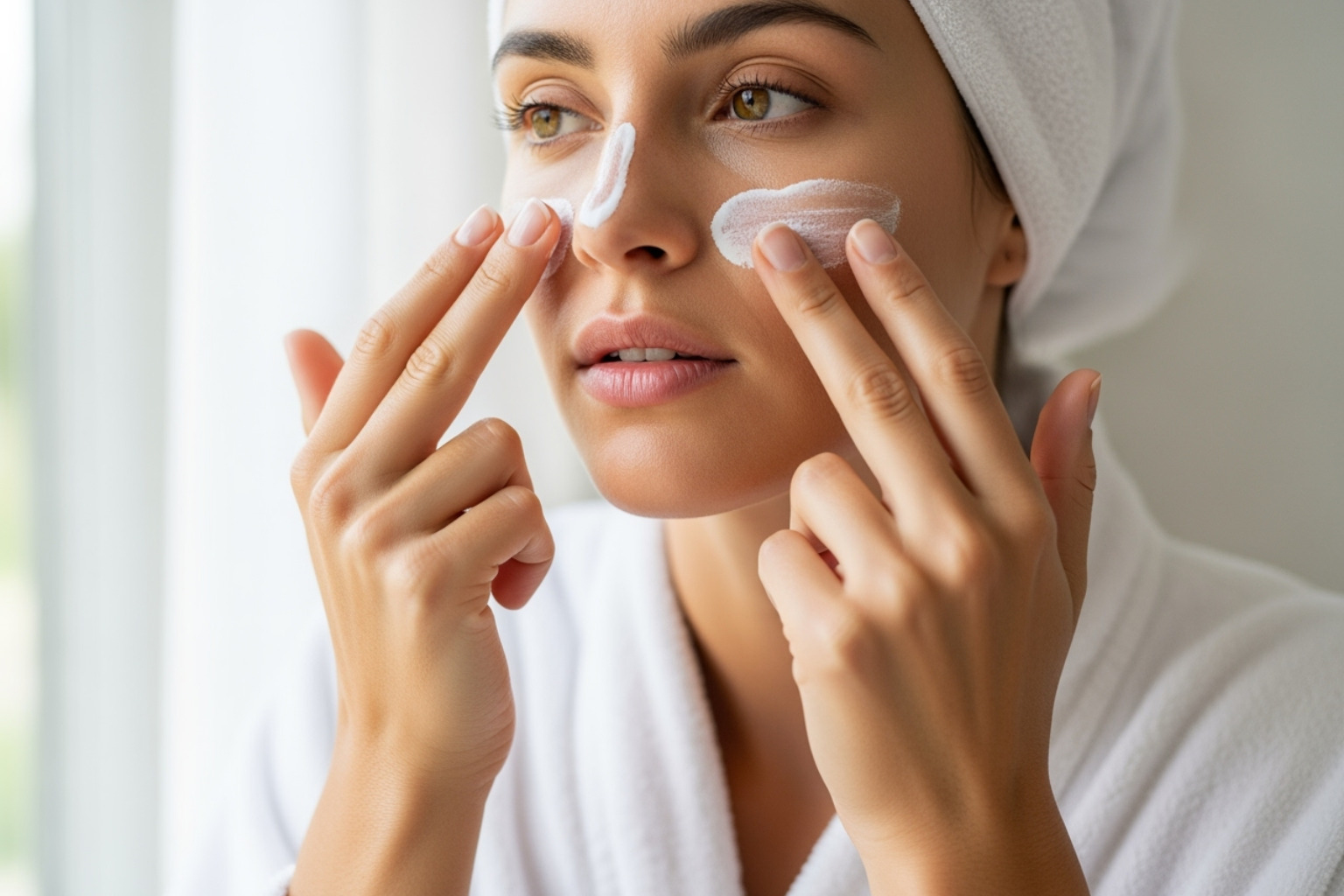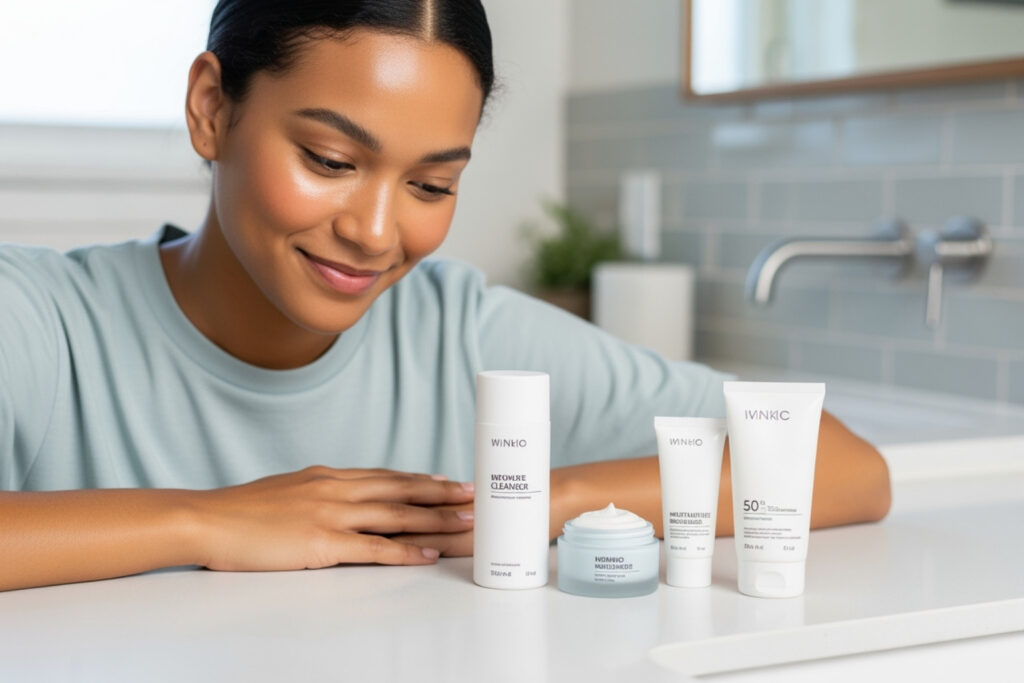Getting Started: Why a Simple Skincare Routine is Your Best First Step
Skincare for beginners can feel like stepping into a maze of endless products, confusing ingredient lists, and contradictory advice. The global skincare market, valued at over 131 billion dollars, offers thousands of options that promise miraculous results overnight. But here’s the truth: simple works better than complex.
Essential Skincare Steps for Beginners:
- Cleanse – Remove dirt and impurities with a gentle cleanser
- Moisturize – Hydrate and protect your skin barrier
- Protect – Apply broad-spectrum SPF 30 or higher sunscreen daily
That’s it. These three steps form the foundation of healthy skin.
The skinimalism trend isn’t just a buzzword – it’s backed by dermatologists who emphasize that consistency beats complexity every time. As one skincare expert noted, “A skincare routine doesn’t need to be overly involved or expensive” to be effective.
Starting simple offers real benefits. Your skin gets time to adjust without overwhelming reactions. You save money by avoiding products you don’t actually need. Most importantly, you’re more likely to stick with a routine that takes just minutes each day.
Many people with great skin follow this exact three-step approach. They’ve finded that taking care of your skin isn’t about having a bathroom full of serums – it’s about building healthy habits that support your skin’s natural functions.
The beauty industry wants you to believe skincare is complicated. It’s not. Your skin replaces itself every 28 days, and with the right foundation, you can support this natural process effectively.

Find more about Skincare for beginners:
The Foundation: How to Identify Your Unique Skin Type
Think of your skin as your unique fingerprint – no two people have exactly the same needs. Before you start building your skincare for beginners routine, you need to become best friends with your skin type. It’s like getting to know a new roommate – once you understand their quirks and preferences, everything becomes so much easier!
Your skin type is the foundation that determines which products will make your skin happy versus which ones might cause drama. As dermatologists often remind us, a skin care routine should be custom to your skin type and goals, not just copied from your favorite influencer.
Oily skin loves to produce extra sebum, giving you that shiny look by midday. If your face feels like you could fry an egg on it a few hours after washing, and your pores are visible enough to have their own zip code, you’re likely in the oily skin club. The upside? You’ll probably age more slowly thanks to all that natural moisture.
Dry skin is the opposite personality – it’s always asking for more hydration. Does your skin feel tight after washing, like it’s been shrink-wrapped? Do you notice flaky patches or a dull complexion that lacks that healthy glow? Your skin is probably crying out for more moisture and oil.
Combination skin is like having a split personality on your face. Your T-zone (forehead, nose, and chin) acts like oily skin, getting shiny and sometimes breaking out, while your cheeks behave more like dry or normal skin. It’s the most common skin type, so you’re in good company if this sounds familiar.
Sensitive skin is the drama queen of skin types, but not by choice. It reacts to new products faster than you can say “patch test,” often with redness, stinging, or breakouts. If your skin throws tantrums with new products or environmental changes, you likely have sensitive skin that needs extra gentle care.
Normal skin is the golden child – well-balanced, rarely problematic, with small pores and a smooth texture. If this is you, count your blessings, but don’t skip the basics!
The simple at-home wash test can help you figure out your skin type. Wash your face with a gentle cleanser, pat it dry, then wait about an hour without applying anything. Now play detective: Is your whole face shiny? That’s oily. Feeling tight and uncomfortable? Dry skin. Shiny T-zone but normal cheeks? Combination. Any redness or irritation? Sensitive. Feeling just right? You’ve got normal skin.
Understanding your unique skin helps you make smarter choices and avoid the trial-and-error game that can irritate your skin and drain your wallet. For more personalized guidance, check out our Natural Skincare Tips to complement your skin type knowledge.

The Core Three: Your Essential Morning and Night Routine
Ready to build your routine? Here’s where the magic happens! Once you understand your skin type, creating an effective skincare for beginners routine becomes surprisingly simple. Think of it like learning to drive – you master the basics first, then add the fancy moves later.
Your morning routine is like putting on armor for the day, focusing on protection from environmental damage. Your nighttime routine? That’s when the real repair work happens while you sleep. Your skin actually regenerates faster at night, making it the perfect time for nourishing ingredients to work their magic.
The beauty of starting simple is that you’ll actually stick with it. A routine that takes five minutes is infinitely better than a complicated 20-step process you abandon after a week. As board-certified dermatologist Michele Farber wisely notes, “In creating your first skin-care routine, keep it simple.”
Let’s break down each essential step so you can start building healthy habits today. For more detailed guidance on establishing consistency, check out our Easy Steps for a Simple Skin Care Routine.
Step 1: Cleanse – The Fresh Start
Think of cleansing as hitting the reset button on your face. Throughout the day and night, your skin collects quite a bit of baggage – dirt, oil, makeup, pollution, and even dead skin cells. A good cleanser sweeps all this away, creating a clean canvas for the good stuff you’ll apply next.
Here’s the thing about cleansing: gentle is the goal. Your skin shouldn’t feel tight or “squeaky clean” afterward – that’s actually a sign your cleanser is too harsh and stripping away your skin’s natural protective oils.
Most people benefit from cleansing twice daily. Morning cleansing removes any overnight buildup (yes, your skin gets busy while you sleep!), while evening cleansing tackles the day’s accumulation.
Gel cleansers feel refreshing and work beautifully for oily or combination skin, providing a thorough clean without heaviness. Cream cleansers are like a gentle hug for dry or sensitive skin, offering hydration while they cleanse. Foaming cleansers create that satisfying lather and typically suit normal to oily skin types.
For oily skin, look for gel or foaming formulas that control excess oil without overdrying. Dry skin thrives with cream cleansers containing hydrating ingredients like hyaluronic acid or ceramides. If you have sensitive skin, stick with ultra-gentle, fragrance-free formulations.
The key is finding a cleanser that leaves your skin feeling comfortable and ready for the next step. If you’re dealing with oily skin and large pores specifically, our Skincare Routine for Oily Skin with Large Pores offers targeted advice.
Step 2: Moisturize – Hydrate and Repair
Here’s a truth that surprises many skincare for beginners: everyone needs moisturizer, even if you have oily skin! Your skin barrier is like a protective brick wall, and moisturizer acts as the mortar that keeps everything strong and intact.
When you skip moisturizer, especially after cleansing, your skin often goes into panic mode. Oily skin types might find their skin actually produces more oil to compensate for the dryness, potentially leading to more breakouts. It’s like your skin is saying, “Help! Send backup oil!”
Hydration is absolutely vital for healthy, resilient skin that can handle whatever life throws at it. Moisturizers don’t just make your skin feel nice – they support your skin’s natural repair processes and help maintain that crucial protective barrier.
The superstars to look for include hyaluronic acid, which can hold up to 1,000 times its weight in water (talk about impressive!), drawing moisture into your skin for that coveted plump, dewy look. Ceramides are naturally found in your skin barrier, so adding them back helps repair and strengthen your skin’s defenses. Glycerin acts like a moisture magnet, pulling hydration from the air into your skin.
Noncomedogenic moisturizers are especially important for oily or acne-prone skin – this fancy term simply means the product won’t clog your pores. Lightweight moisturizers like gels or gel-creams provide hydration without feeling heavy, perfect for oily and combination skin. Rich creams offer intense hydration for dry or mature skin that needs extra nourishment.
Step 3: Protect – The Ultimate Anti-Aging Secret
If you could only do one thing for your skin, make it this: wear sunscreen every single day. We’re not being dramatic – UV radiation is responsible for up to 90 percent of visible skin aging. Those wrinkles, dark spots, and loss of firmness? Most of that comes from sun damage, not just the passage of time.
Think of sunscreen as your skin’s personal bodyguard. Even on cloudy days, UV rays sneak through clouds and windows, making daily protection essential. It’s honestly the most powerful anti-aging product you can use, and it’s available at any drugstore.
Always choose a broad-spectrum sunscreen with SPF 30 or higher. “Broad-spectrum” means it protects against both UVA rays (the aging ones) and UVB rays (the burning ones). You want protection from both troublemakers.
Mineral sunscreens work like tiny mirrors on your skin, reflecting UV rays away. They contain zinc oxide or titanium dioxide and are often the gentlest choice for sensitive skin. Chemical sunscreens absorb UV rays and convert them to heat, then release it from your skin. They typically feel lighter and blend in more easily, making them popular for daily wear under makeup.
Apply sunscreen as your final morning step, using about a nickel-sized amount for your face and neck. Don’t forget to reapply every two hours if you’re spending time outdoors.
Finding the right sunscreen for your skin type can feel tricky, but it’s worth the effort. Our guide on the Best Sunscreens for Oily and Acne-Prone Skin can help you steer your options.

Leveling Up Your Skincare for Beginners: When to Add More Steps
Here’s the exciting part of your skincare for beginners journey – once you’ve been consistent with your core three steps for at least 4-6 weeks and your skin feels happy and balanced, you might be ready to explore beyond the basics! Think of this as moving from skincare kindergarten to elementary school – we’re still keeping things simple, just adding a few more tools to your toolkit.
The golden rule here is patience. Your skin didn’t develop its current concerns overnight, and it won’t transform overnight either. Introduce new products slowly – we’re talking one new product every 2-3 weeks. This way, if something doesn’t agree with your skin, you’ll know exactly what the culprit is. Adding five new products at once is like trying to solve a puzzle while wearing a blindfold!
Before trying any new product on your face, always patch test. It sounds fancy, but it’s really simple: apply a tiny amount behind your ear or on your inner wrist, then wait 24-48 hours to see if any redness, itching, or irritation appears. Your face will thank you for this extra step of caution.
As you start layering more products, remember the basic rule: apply from thinnest to thickest consistency. Think of it like getting dressed – you wouldn’t put your coat on before your shirt! For more detailed guidance on this, check out our guide on How to Layer Skincare Products Correctly.
Introducing Toners and Essences
If toners and essences seem confusing, you’re not alone! Many people in the skincare for beginners community wonder if these steps are really necessary. The truth is, while not essential, they can be wonderful additions once you’ve mastered your basics.
Modern toners have come a long way from the harsh, alcohol-based formulas your mom might remember. Today’s toners serve multiple purposes: they can balance your skin’s pH after cleansing, add an extra layer of hydration, or provide gentle exfoliation. Think of toner as the appetizer before the main course – it prepares your skin to better absorb everything that comes next.
Hydrating essences, a beloved staple in Korean skincare routines, are like a drink of water for your skin. These lightweight, watery formulas are packed with hydrating and nourishing ingredients that penetrate deeply into your skin. You simply pat them gently onto clean skin, and they help boost hydration while prepping your skin for serums and moisturizers.
The beauty of both toners and essences is that they’re generally gentle and suitable for most skin types, making them perfect stepping stones for beginners ready to expand their routine.
Targeted Treatments: Serums and Eye Creams
Now we’re getting into the fun stuff! Serums are like the specialists of the skincare world – each one is designed to target specific concerns with concentrated active ingredients. They’re typically applied after cleansing and toning but before moisturizer.
Vitamin C serums are fantastic for brightening your complexion and protecting against environmental damage. They’re like a cup of coffee for your skin – energizing and protective! Niacinamide (also called Vitamin B3) is a gentle multitasker that can help minimize the appearance of pores and improve uneven skin tone. It’s particularly great for beginners because it plays well with almost all other ingredients.
If you’re interested in anti-aging benefits, ingredients like retinol can be incredible additions, though they require more careful introduction. For comprehensive guidance on this topic, our Anti-Aging Skincare Routine for Beginners covers everything you need to know.
The delicate eye area often shows the first signs of aging, which is why eye creams exist. While not absolutely essential for every beginner, if you’re concerned about fine lines, dark circles, or puffiness around your eyes, a gentle eye cream can be a worthwhile investment.
Understanding Exfoliation: A Key Step in Skincare for Beginners
Exfoliation is essentially giving your skin a fresh start by removing dead skin cells that can make your complexion look dull or cause clogged pores. Think of it as clearing away the old to make room for the new! When done correctly, exfoliation can improve skin texture and help your other products absorb better.
The key word here is “correctly.” Over-exfoliating is one of the most common mistakes beginners make, leading to irritation, redness, and a damaged skin barrier. Start with exfoliating once a week, and only increase frequency if your skin tolerates it well.
You have two main options for exfoliation:
| Exfoliant Type | How it Works | Best For |
|---|---|---|
| Physical Exfoliants (scrubs, brushes) | Use friction to physically buff away dead skin cells | Normal to oily skin types who prefer a more tactile experience |
| Chemical Exfoliants (AHAs like glycolic acid, BHAs like salicylic acid) | Use gentle acids to dissolve the bonds between dead skin cells | Most skin types, especially sensitive skin or those with acne concerns |
Chemical exfoliants might sound scary, but they’re often gentler than physical scrubs. AHAs (like glycolic acid) are great for surface-level concerns like dullness and fine lines, while BHAs (like salicylic acid) can penetrate into pores, making them excellent for oily or acne-prone skin.
With any form of exfoliation, your skin becomes more sensitive to sun damage, making daily sunscreen use even more crucial. Your skin will literally be showing its newer, more vulnerable layers to the world!







